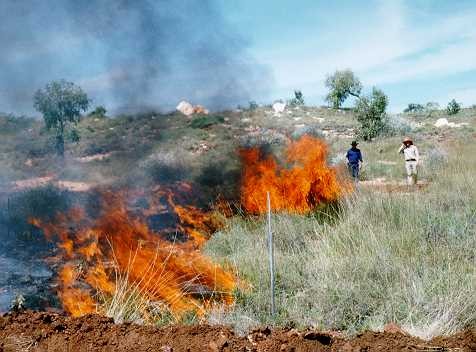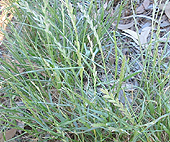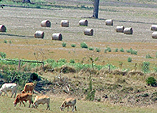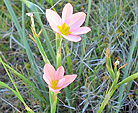module 17A
Integrated weed management in cropping systems
Objectives
At the end of this module, you will be able:
- be familiar with the integrated management of weeds in broad area cropping, concentrating on the southern Australian wheat belt
- be able to describe the principles of integrated weed management in cropping
- explain the impact of different weed management methods on cropping systems
Module Outline
- Introduction
- Overall strategies for weed management
- Cropping in the Australian wheat belt
- Management methods for annual crop weeds
- Problems from herbicide reliance for weed management
- An example: IWM in southern Australian cropping
- Summary
- References and further reading
Introduction
Weedy plant species have always been and will continue to be a significant limitation within cropping systems. Cost-efficient management of weed populations in such systems is critical as weeds
- reduce crop yields
- hinder harvest operations
- contaminate produce
- host diseases and insects
Profitable and sustainable cropping systems maximise the growth and yield of crop plants while reducing the growth and reproduction of weeds to the extent that they result in minimal economic impact and can be kept at manageable levels. Weeds are rarely if ever eradicated from annual cropping systems. The critical goal must be to reduce weed seed reserves to levels such that weeds can be adequately and economically controlled within the farming system using the weed control methods available.
In order to be effective and to contribute to profitable and sustainable cropping systems, weed control strategies must:
be built on a solid foundation of good agronomy. The crop must be given every chance to provide maximum competition to the weeds and weed control must be seen as an integral component of any good farming systems' management
avoid heavy reliance on one or two control methods, especially herbicides with the same mode of action. Heavy reliance on one or two methods of control over an extended period of time can lead to weeds that escape the treatment(s) and, in the case of herbicides, the development of herbicide resistance
What is required is an approach to weed control that integrates good agronomy and paddock management with as wide a range of weed control methods as possible. This is what is known as "Integrated Weed Management" (IWM), which is in turn part of an integrated approach to crop production or "Integrated Crop Management". The aim of such an approach is to ensure cropping systems are managed in a way that sustains profitable production and reduces the risk of herbicide resistance and specific weeds getting out of control.

Figure 17.1. An integrated approach
to weed management. Integrated weed management (IWM)
involves incorporating into the overall farming management as many weed control
methods as
appropriate, in order to avoid over reliance on one particular control option,
to optimise weed control,
and to sustain profitable production.
Overall strategies for weed management
There are three steps to following an integrated approach to weed management viz.:
- gain a good understanding of the problem, that is the weeds that are likely to be encountered. A whole series of questions need to be asked
- to make decisions about the best weed control practices
to employ, use the knowledge and understanding that you have gained about
the weeds i.e.
- paddock history
- potential for herbicide resistance
- potential for soil residue problems
- crop disease implications
- other management considerations - put the strategy into action and get the best out of the control methods
In other words this is about best practice and "doing it well" under the conditions that apply at the time. For example, weed populations can quickly get out of hand if a herbicide application fails due to:
- poor timing
- use of the wrong product or rate, or
- weeds being under stress at the time of application (see Module 15)
With the threat of, and in many situations the onset of, herbicide resistance across much of the cropping areas of Australia it is becoming more and more important to record and monitor a whole range of actions and results associated with weeds. This is where the escape weeds will be discovered, resistant populations identified, and the need for changes to the strategy highlighted (Figure 17.1).
A review of the results of the weed control practices employed will help highlight areas for further investigation. This will prove valuable in updating the knowledge base and understanding the problems with the cropping system as a whole. The planning-management cycle then continues with the aim being to optimise weed control and improve the prospects of profitable production, whilst at the same time reducing the risk of new problems emerging. These issues are highlighted in the following reading, which illustrates how to collect and record data that will allow planning of the best strategy.
|
In this section we will concentrate on weed management within the temperate annual cropping zone of Australia commonly referred to as the wheat belt. Figure 14.2 depicts this huge area west of the ranges on the east coast and stretching from southern Queensland, through NSW, Victoria and South Australia, and including a large part of temperate Western Australia. Within this vast area the dominant agricultural activity is rain-fed annual cropping centred on cereals, predominantly wheat, grown in rotation with pulse crops and annual legume-based pastures grazed mostly by sheep but occasionally by cattle.
Crop production in the southern wheat belt is geared to a Mediterranean-type climate characterised by a:
- lengthy hot summer devoid of significant rainfall
- winter to spring growing season of approximately 300 - 500 mm rainfall
| Table 14.1 The agronomic activities associated with a cereal crop in southern Australia | |
| Month | Description |
| May - June | Seeding occurs |
| June - August | The young crop emerges and grows slowly through the usually wet winter months |
| September - October | A short period of rapid growth before the onset of flowering during the warmer yet still moist early weeks of spring. |
| October - December | Seed maturation occurs as the day temperatures rise and water stress is experienced in late spring to early summer |
| December | Harvest is usually undertaken by which time the day temperatures are into the high 20Cs or low 30Cs and the landscape has dried off |
Figure 17.2. The Australian wheat belt. Adapted from Kelleher (1994).
Cropping in the Australian wheat belt
Throughout the 150-year history of cropping in the wheat belt, the farming systems practiced have of necessity reflected the prevailing economic conditions.
| When | Activity |
| Prior to the 1960s | Wheat belt was very much the sheep-wheat belt as grazing of sheep primarily for wool but also for meat was the predominant enterprise on most farms in the zone. |
| early to mid 1900s |
Recognition of the benefits of superphosphate dressing and the ready
availability of this fertiliser and farmers saw the advantages of encouraging
the growth of annual legume-based pastures. This had the dual benefit
of:
As wool prices dropped, farmers started to grow more grain crops especially wheat. |
| 1970s | A range of pre-emergent and post-emergent herbicides released allowing farmers to greatly reduce fallowing and the number of tillage operations required to establish a grain crop. |
| 1980s | Availability of a range of very effective, highly selective herbicides for use in the crop. As well, the use of chemicals such as paraquat, diquat and glyphosate for reducing tillage was refined, which eventually allowed the direct drilling of crops. |
| 1990s | Farmers had all the necessary weed control tools to continuously crop and to direct drill such crops, provided that other factors such as diseases were kept under control. |
Apart from wheat quotas in the seventies, the economic climate has overall favoured farmers with arable land in the wheat belt to maximise the area sown to grain each year, resulting in more intensive cropping throughout most of the wheat belt.
The 1980s and 1990s have seen farmers reducing tillage operations, increasing the intensity of cropping, aiming for grass free farming (for disease control), and the retention of crop stubble. These practices have been readily adopted; however, as they rely extensively on the highly effective grass herbicides and, more recently, the equally effective broadleaf herbicides, herbicide resistance has resulted (see Module 16 for more information on herbicide resistance).
It is important to realise that farm sizes are relatively large in the wheat belt and that economic realities and returns dictate that farmers can only afford very restricted inputs (fertiliser, etc.) and little employed labour compared to other agricultural enterprises. Farms are now highly mechanised and farm sizes have been increasing, such that now there are only about 50,000 grain producers in the wheat belt. On average, each of these farmers will almost single-handedly seed, nurture, and harvest some 600 hectares of crop annually. By any criteria these farmers are amongst the most efficient in world agriculture.
Management methods for annual crop weeds
The first phase of developing an integrated weed management strategy is to understand the available management methods, their advantages and limitations. The following reading considers chemical and physical methods of weed control as well as the use of crop rotations for southern grain-growing systems.
|
Physical methods of weed control
The physical methods of weed control that can be used to manage annual weeds of cropping include:
- burning
- crop pasture rotations
- crop topping
In addition, no-till cropping can be used.
No-till cropping
One issue not extensively covered in the previous reading is the increasing trend towards no-till cropping in southern Australia. No-till is where there are no tillage operations prior to sowing the crop and the crop is sown with a knife-point opener or a disc. The advantages of no-till can be large with:
- improved soil structure
- increased organic matter content
- more timely seeding
- reduced emergence of weeds requiring seed burial (see also Module 10)
Burning
The use of burning is well discussed in the reading. However, it is important to realise that burning of standing weeds destroys a much greater percentage of weed seed than burning seed and stubble on the soil surface (Figure 14.3). Therefore, in most circumstances burning will reduce weed seed numbers by only a small amount unless the burn is hot. A hot burn requires a lot of stubble to carry it. Therefore, if burning is to be used for disease or snail management, the effects on weeds can be increased by leaving straw longer and keeping stock out of the paddock.

Figure 17.3. Burning will remove seed from standing weeds and some from
the soil surface;
however, it also removes stubble. The bare soil is prone to wind erosion.
Crop pasture rotations
The use of crop pasture rotations is discussed on page 296 of the reading above. Where pastures are used as part of the crop rotation, it is vitally important that weeds are effectively managed in the pasture phase prior to cropping. The following reading examines the importance of managing weeds in pasture before returning to the cropping phase. The reading contains practical hints for the use of a pasture phase to control Lolium rigidum and Hordeum leporinum.
|
Crop topping
Crop topping is the practice of applying herbicides late in
the season to control weed seed set. This practice has found significant application
in southern Australian cropping systems, particularly where herbicide resistant
weeds are a problem. The following reading discusses the advantages of crop
topping in reducing seed set of Lolium rigidum.
You should note that timing of herbicide application is a major problem. Typically
growers tend to be conservative and apply the herbicide later than the optimal
time for reduction of weed seed set so as to maximise crop yield.
|
Problems from herbicide reliance for weed management
Given the massive reliance on herbicides for weed control in modern agriculture it was inevitable that there would be some repercussions from reliance on this one tool. One repercussion is the appearance of herbicide residues in soil and water. Herbicide residues involve both political and biological issues:
- political considerations are that some in the community consider that any agrochemical residues are unacceptable and pesticide use should be restricted or abolished
- biological issues include that herbicide residues may have adverse effects on other crops or pastures, residues may be transported to other areas or may contaminate farm produce.
Detailed consideration of the real and perceived issues involved with herbicide residues are outside the scope of this section, but are discussed in Module 15.
As discussed in Module 16, a biological repercussion of the widespread reliance on herbicides for weed control is the development of herbicide resistant weed biotypes.
Herbicide resistance poses a massive threat to the continued efficacy of herbicides in Australian agriculture and, therefore, a threat to the sustainability of our cropping systems. As will be outlined in the following section it is essential that the herbicide dependence of Australian agriculture is reduced and IWM strategies are implemented.
An example: IWM in southern Australian cropping
Integrated weed management (IWM) for cropping systems is occurring as a direct consequence of the evolution of herbicide resistant weeds. The following reading discusses why IWM needs to occur and provides three case studies.
|
Several novel activities are discussed in this reading
including:
- increased seeding rates
- variation in sowing time
- collecting weed seed at harvest.
The following three readings examine some of theses issues in greater detail:
- the first gives an overview of the need to have an integrated approach to weed management in cropping because of herbicide resistance. It also lists a number of possible strategies
the second looks at another promising strategy being pursued by a small number of farmers; the retention of weed seed, principally L. rigidum (right) although other weeds can also be retained, in the harvest operation. Weed seed are usually returned to the paddock along with the chaff by harvesting equipment. Various techniques that are being employed to intercept and retain weed seed range from trailing bins, commercially available header attachments or modifications to funnel and then burn seed. Substantial L. rigidum seed can be removed in this manner and that seed capture at harvest can be a valuable component of an IWM strategy. Currently, Australian farmers are not satisfied with the machinery aspects of this technique and substantial further innovation is required before the practice will be widely adopted.
- the final reading illustrates how a range of IWM techniques can help manage grass weeds on farms and the financial benefits and costs of implementing IWM.
Summary
Herbicides have been, and will continue to be, the tool of choice for weed control in cropping systems. However, the advent of herbicide resistant has meant that weed control technologies other than herbicides need to be included in IWM. IWM requires longer term planning than short term herbicide decision making. While alternatives to herbicides may be more expensive in the short term, there can be long term advantages. Ideally, IWM should become an integral part of cropping, including crop choice and other management decisions.
References and further reading
Gill, GS & Holmes, JE 1997, ‘Efficacy of cultural control methods for combating herbicide-resistant Lolium rigidum’, Pesticide Science, vol. 51, pp. 352- 358.
Gill, G, Holmes, J & Kelly, R 1994, Herbicide Resistance: A Reference Manual, Department of Agriculture, WA, South Perth.
Kelleher, FM 1994, ‘Climate and crop distribution’, in JE Pratley (ed), Principles of Field Crop Production, 3rd edn, Oxford University Press, Melbourne,pp. 26-117.
Pannell, DJ & Zilberman, D 2001, ‘Economic and sociological factors affecting growers’ decision making on herbicide resistance’, in SB Powles & DL Shaner (eds), Herbicide resistance and world grains, CRC Press, Boca Raton, Fl, pp. 251-277.
Poole, ML 1987, ‘Tillage practices for crop production in winter rainfall areas’, in PS Cornish & JE Pratley (eds), Tillage: New Directions in Australian Agriculture, Inkata Press, Melbourne, pp. 24-47.
Powles, SB & Matthews, JM 1992, ‘Multiple herbicide resistance in annual ryegrass (Lolium rigidum): A driving force for the adoption of integrated weed management’, in I Denholm, AL Devonshire and DW Hollomon, (eds), Resistance ‘91: Achievements and Developments in Combatting Pesticide Resistance, Elsevier Applied Science, London, pp. 75-87.
Powles, SB, Preston, C, Bryan, IB & Jutsum, AR 1997, ‘Herbicide resistance: Impact and management’, Advances in Agronomy, vol. 58, pp. 57-93.
Pratley, JE & Rowell, DL 1987, ‘From the first fleet - evolution of Australian farming systems’, in PS Cornish & JE Pratley (eds), Tillage: New Directions in Australian Agriculture, Inkata Press, Melbourne, pp 2-23.
Preston, C, Roush, RT & Powles, SB 1999, ‘Herbicide resistance in southern Australia: why are we the worst in the world?’ Twelfth Australian weeds conference, papers and proceedings, pp. 454-459.
Thill, DC & Lemerle, D 2001, ‘World wheat and herbicide resistance’, in SB Powles & DL Shaner (eds), Herbicide resistance and world grains, CRC Press, Boca Raton, Fl, pp. 165-194.
Self assessmentDo you know:
|


